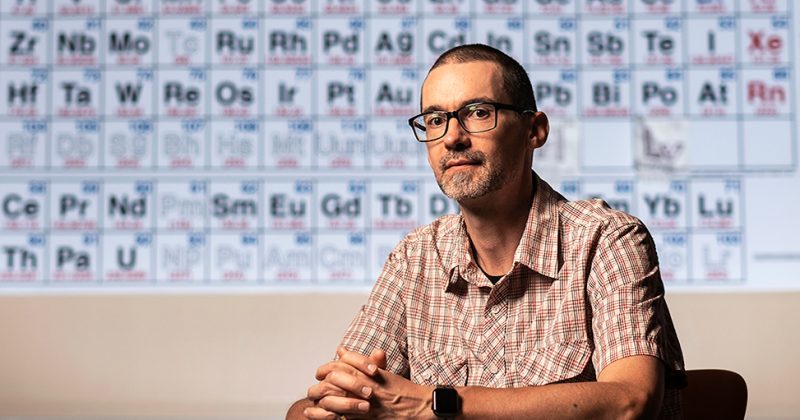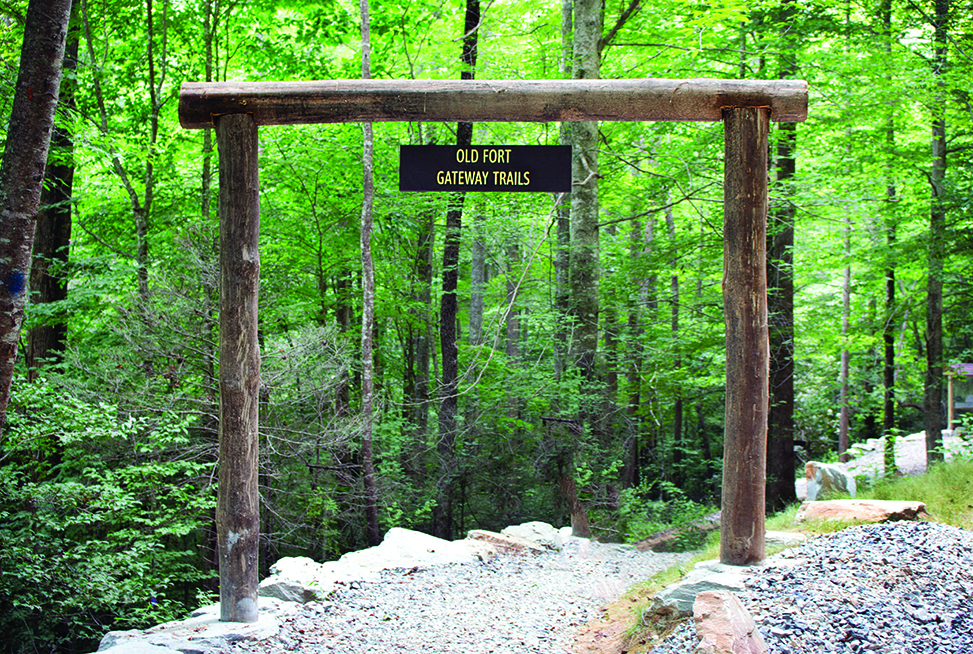
The Old Fort trails gateway arch welcomes visitors (photo by Jess Abel).
Editor’s note: This story is part of a package of stories featuring UNC researchers “in the field” in Colorado, North Carolina and on the Afghanistan-Pakistan border. Read “Crouching researcher, hidden sparrow” and “Preserving endangered manuscripts.”
A creative collaborative supported by Southern Futures is conceiving a bright future for Old Fort, North Carolina, focused on sharing the town’s history and creating opportunities in the outdoor economy.
 The Old Fort trails gateway arch welcomes visitors (photo by Jess Abel).
The Old Fort trails gateway arch welcomes visitors (photo by Jess Abel).
Old Fort native Lavita Logan remembers fondly the childhood summers she spent swimming in Curtis Creek. Her father introduced her to a love of the outdoors, a passion she still shares today.
In June, a ribbon-cutting celebrated the opening of six miles of accessible, multi-use trails at the Old Fort Gateway Trailhead in the Pisgah National Forest near that same gurgling creek.
Hundreds of trail enthusiasts gathered on a cloudy day to explore the first phase of a 42-mile trails project that will roll out over the next five to 10
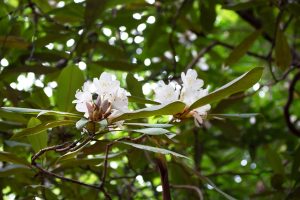
years. Mountain bikers high-fived hikers, kids splashed in the creek searching for water critters, and riders saddled up horses for their turn on the trails where the rhododendron was in full bloom.
Logan leads the group People on the Move Old Fort, a program of the West Marion Community Forum. It is part of a diverse partnership called the Catawba Vale Collaborative that spearheaded the trails project and is re-imagining a new future for Old Fort — one in which locals, especially people of color, take advantage of the town’s outdoor recreation assets and play a key role in tourism-related small business development.
The collaborative also includes Camp Grier and its nonprofit G5 Trail Collective, Eagle Market Streets Development Corporation, the U.S. Forest Service Grandfather Ranger District and university archaeologists from UNC-Chapel Hill and Texas Tech University. The project is supported by Carolina’s Southern Futures initiative — a cross-campus collaboration that works toward equity, justice and possibility in the U.S. South.
Logan, who wants to get more Black people out on the trails, said, “There’s nothing like coming home to the mountains.
“I was driving down Highway 70 one day and I thought, ‘This is so beautiful.’ That’s what has kept me here. This is the place where I need to be. I always wanted to make a change in my community.”
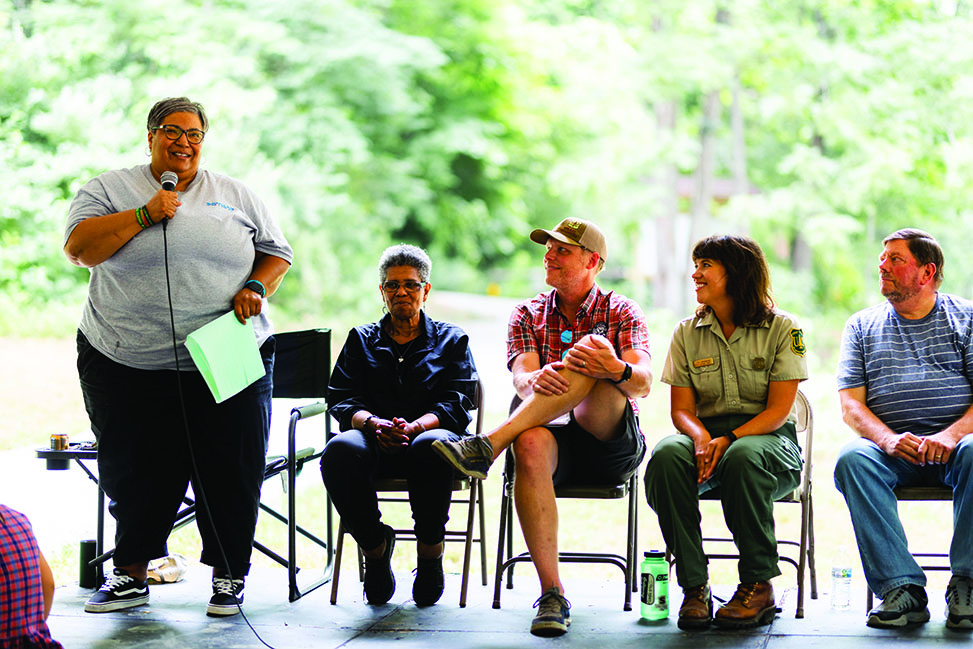 Lavita Logan (standing) with Catawba Vale Collaborative partners, from left, Stephanie Swepson Twitty, Jason McDougald and Lisa Jennings. (photo by Darrell Cassell).
Lavita Logan (standing) with Catawba Vale Collaborative partners, from left, Stephanie Swepson Twitty, Jason McDougald and Lisa Jennings. (photo by Darrell Cassell).
Stories that matter
Jennifer Gates-Foster, associate professor of classics and archaeology at UNC, wants to dispel the romanticized version of swashbuckling archaeology as portrayed in movies. Archaeology is about supporting communities who seek to understand their past and how it shapes the present, she said.
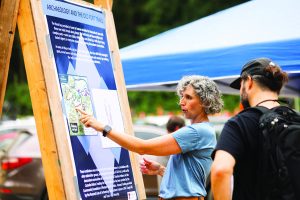
Gates-Foster played a critical role in an important process that had to happen before the onset of the Old Fort trail construction. The National Environmental Policy Act, also known as NEPA, requires federal agencies to assess the environmental effects of their proposed actions prior to land development and “to create and maintain conditions under which man and nature can exist in productive harmony.”
UNC’s Research Laboratories of Archaeology has also supported the work.
“People tend to think of archaeology as the ‘big dig’ model, but it’s also about the palimpsest of human impacts on the landscape — some of those are constructed impacts like remains of old homesteads or roads, but part of what landscape archaeologists do is look at human relationships with the land over the long term,” she said.
In delving into the U.S. Forest Service archives, archaeologists are also learning about the history of the forest itself and its relationship to the community.
The dense forest that exists today is itself an artifact of human intervention due to the Weeks Act, a 1911 law that authorized the U.S. government to purchase land for conservation. It would be unrecognizable to the American Indian communities who lived there 200 to 300 years ago, or to people who occupied the area 10,000 years ago. Before becoming national forest, the land was logged for the timber and tanbark industries.
“The idea of telling the story of the forest is absolutely fascinating,” said Christopher Witmore, a colleague of Gates-Foster who is a professor at Texas Tech University and a North Carolina native. “It’s about how a forest that was completely clear-cut can return and indeed thrive. It’s a story of resilience.”
Archaeologists are working with a local stonemason and an architect to design cairns — stacked stone storytelling pillars — that offer opportunities for reflection and contemplation on the trails. Three of those markers will be placed in November, one at the gateway trailhead and two others at trail connector points.
Gates-Foster noted that these “pause points” will be very different from traditional wayfaring and interpretive park signs that people are used to seeing. Archaeologists will consult with tribal leaders of the Eastern Band of Cherokee Indians and the Catawba Nation (assisted by UNC’s Heather Lapham), the Forest Service and the community of Old Fort on the proposed designs.
“We want to highlight that the forest is a place that doesn’t have a single narrative,” she said.
“The whole project is driven by the idea that everyone should feel welcome. We’re not dictating a particular way of moving through the spaces, but rather inviting people into them.”
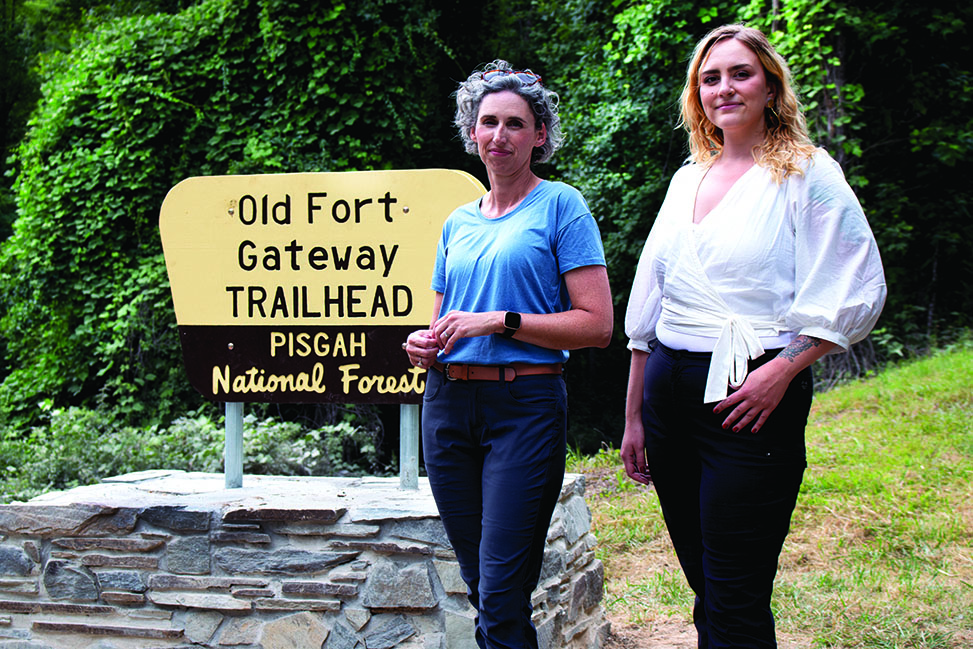 Gates-Foster and UNC doctoral student Cayla Colclasure at the new trailhead gateway sign. (photo by Jess Abel)
Gates-Foster and UNC doctoral student Cayla Colclasure at the new trailhead gateway sign. (photo by Jess Abel)
The value of student research
Last fall, the nonprofit RAIL Project erected a memorial in Old Fort to the incarcerated workers who built the Mountain Division of the Western North Carolina Railroad, which still meanders through downtown today.
Cayla Colclasure, a UNC Ph.D. student in anthropology, received a Southern Futures Townsend Fellowship for work focused on prison labor and the railroad.
It was difficult and dangerous to build the railroad — workers blasted through mountain rock to construct multiple tunnels — and many died.
“After Emancipation, Black people were often unfairly arrested for crimes like larceny and put in prison camps to work on construction projects like railroads,” she said. “I’m interested in the camps themselves — built in the 1870s and 1880s — and how people are discussing this now and grappling with this history, especially in context of the larger project in Old Fort.” [Click here for a companion University Research Week profile on Colclasure.]
The collaborative is involving UNC undergraduate students in the Old Fort project as well. A senior public policy capstone team will examine the economic impacts of the outdoor recreation industry on small mountain towns.
Colclasure and Gates-Foster also conducted a downtown walking interview with Stephanie Swepson Twitty and her husband, Paul — both natives of Old Fort — to further understand the town’s history, which has been affected by the closure of multiple manufacturing industries.
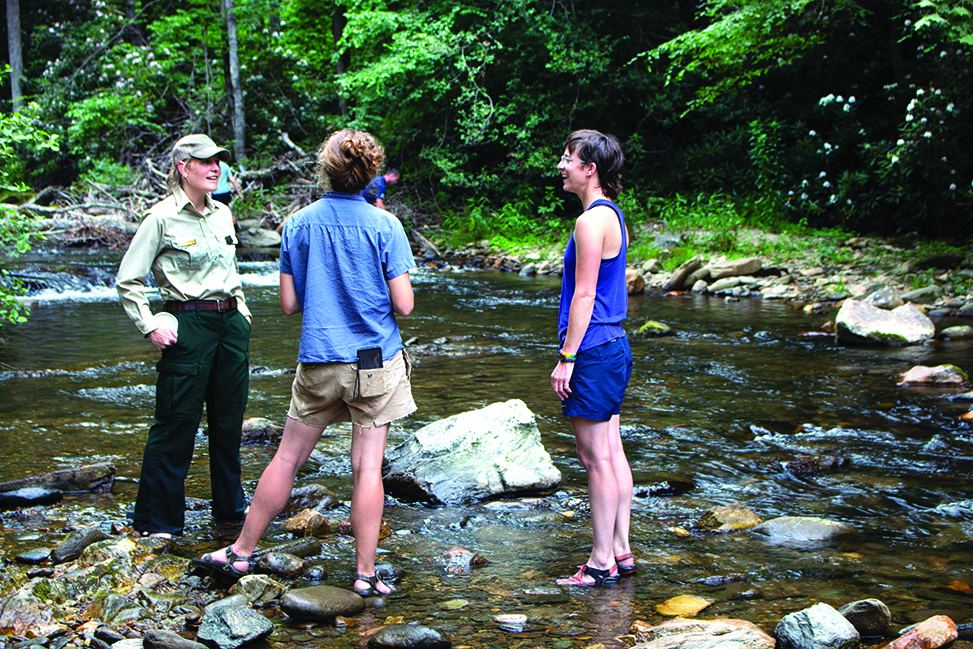 A forest ranger and trail-users enjoy conversation and the cooling waters of Curtis Creek. (photo by Jess Abel)
A forest ranger and trail-users enjoy conversation and the cooling waters of Curtis Creek. (photo by Jess Abel)
Igniting economic development
Swepson Twitty is the CEO of Eagle Market Streets Development Corp., one of the collaborative partners. In July, EMSDC opened the Catawba Vale Business HUB, a coffee shop and co-working space, in a building on Main Street that dates to 1924.
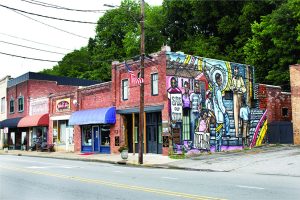
On one side of the building, a colorful mural was painted in 2020 to honor two of the town’s civil rights heroes: George Sandlin and Albert Joyner.
Opportunity Appalachia recently awarded EMSDC and Camp Grier/G5 Trail Collective two grants to spur economic development. Camp Grier will use the funding to develop a 75,000 square foot facility that will contain light commercial space, camping and van spaces, and long- and short-term rental lodging. EMSDC is working to rehabilitate an old furniture warehouse on Commerce Street into a mixed-use facility that would feature light manufacturing, commercial offices, retail and food space.
“Among our partners, there was an understanding that land is an asset, and that asset can drive the economy,” Swepson Twitty said at a community forum that was held in the train depot the day after the opening celebration. “This is a win-win for all the things that need to happen for a healthy, thriving community.”
 A sign welcomes visitors to downtown Old Fort. (photo by Jess Abel)
A sign welcomes visitors to downtown Old Fort. (photo by Jess Abel)
Change is possible
The collaborative partners are aware of the pitfalls that can come with economic development leading to gentrification; they say they are committed to doing it right in Old Fort.
Lisa Jennings, recreation manager for the U.S. Forest Service Grandfather Ranger District, said when it comes to trail-building projects, Old Fort offers a unique model.
“The diversity of the collaborative and the areas that we all represent — trail users, the community, the archaeologists, the community college, small businesses — that’s what makes this project holistic,” she said. “That trust takes time, and it takes effort.”
Jason McDougald, executive director of Camp Grier and G5 Trail Collective, adds that the team is the “secret sauce” that makes it work: “What keeps me here and engaged is the idea of building a better community.”
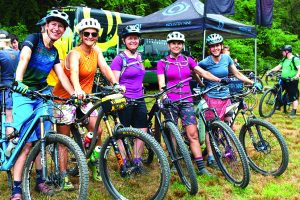
Now that the first phase of trails is open, the work is just beginning. The second “Outdoors for All” summit in mid-October will again bring together diverse community participants, industry partners and trail enthusiasts to continue the discussion about creating equity in shared outdoor spaces.
Work is continuing on renovation of the old fire station in downtown Old Fort; it will house the McDowell Tech Workforce Education Center to support ecotourism, trail development and sustainability. A UNC journalism alumnus is working on a documentary film about the project. Gates-Foster and Colclasure have already done archival work and fieldwork for phase II.
As Jennings helped to put finishing touches on the trail gateway arch before opening day, the significance of this project to the town’s future hit her.
“We took photos and I thought, ‘How many people over hundreds of years will take pictures under this one spot, under this one sign?’ It’s a legacy that this collaborative can leave on the landscape forever.”
Read a previous story at go.unc.edu/oldfort.
By Kim Weaver Spurr ’88
Published in the Fall 2022 issue | Features
Read More

How to help endangered monarch butterflies
Many people admire migratory monarch butterflies for their beauty and…
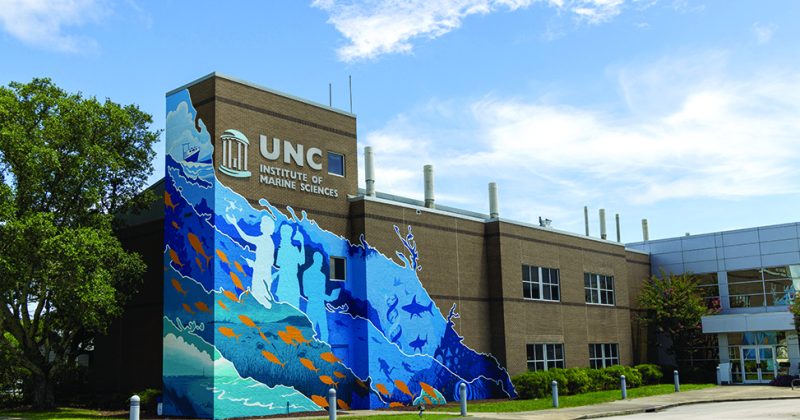
Mural, mural on the wall. Who’s the saltiest of them all?
North Carolina muralist Max Dowdle, top left, was chosen after…


